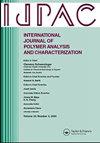Study on water properties and spatial structure of water in poly(2-methoxy ethylacrylate)s with different molecular weights by nuclear magnetic resonance spectroscopy
IF 1.6
4区 工程技术
Q4 POLYMER SCIENCE
International Journal of Polymer Analysis and Characterization
Pub Date : 2025-02-23
DOI:10.1080/1023666X.2025.2467164
引用次数: 0
Abstract
Poly(2-methoxyethyl acrylate) (PMEA) is known for its favorable blood compatibility, attributed to its unique intermediate water content, as identified by differential scanning calorimetry. Previously, we reported that PMEA contains two types of water—upfield and downfield waters—characterized by 2H-nuclear magnetic resonance (2H-NMR) and proposed that upfield water is a key factor in expressing good blood compatibility. In the present study, further investigations of the role of upfield water and clarification of the spatial water structure were performed using PMEAs with different molecular weights. 2H-NMR analysis revealed that the upfield water content was almost constant, regardless of the molecular weight, whereas the downfield water content increased with an increase in the molecular weight of PMEA. Based on these findings, the role of upfield water is discussed. Homonuclear and heteronuclear Overhauser effect spectroscopies revealed that upfield water existed near the methoxy group of PMEA, within a 0.5 nm range.
核磁共振波谱法研究不同分子量聚(2-甲氧基乙基丙烯酸酯)中水的性质及水的空间结构
聚(2-甲氧基乙基丙烯酸酯)(PMEA)以其良好的血液相容性而闻名,这归功于其独特的中间含水量,如差示扫描量热法所识别的那样。之前,我们报道了PMEA含有两种类型的水-上场水和下场水-通过2h核磁共振(2H-NMR)表征,并提出上场水是表达良好血液相容性的关键因素。在本研究中,我们使用不同分子量的pmea进一步研究了上场水的作用,并澄清了空间水结构。2H-NMR分析表明,无论PMEA的分子量如何,上场含水量几乎不变,而下场含水量随着PMEA分子量的增加而增加。在此基础上,讨论了上油田水的作用。同核和异核Overhauser效应光谱显示,在PMEA的甲氧基附近,在0.5 nm范围内存在上场水。
本文章由计算机程序翻译,如有差异,请以英文原文为准。
求助全文
约1分钟内获得全文
求助全文
来源期刊
CiteScore
3.50
自引率
5.30%
发文量
37
审稿时长
1.6 months
期刊介绍:
The scope of the journal is to publish original contributions and reviews on studies, methodologies, instrumentation, and applications involving the analysis and characterization of polymers and polymeric-based materials, including synthetic polymers, blends, composites, fibers, coatings, supramolecular structures, polysaccharides, and biopolymers. The Journal will accept papers and review articles on the following topics and research areas involving fundamental and applied studies of polymer analysis and characterization:
Characterization and analysis of new and existing polymers and polymeric-based materials.
Design and evaluation of analytical instrumentation and physical testing equipment.
Determination of molecular weight, size, conformation, branching, cross-linking, chemical structure, and sequence distribution.
Using separation, spectroscopic, and scattering techniques.
Surface characterization of polymeric materials.
Measurement of solution and bulk properties and behavior of polymers.
Studies involving structure-property-processing relationships, and polymer aging.
Analysis of oligomeric materials.
Analysis of polymer additives and decomposition products.

 求助内容:
求助内容: 应助结果提醒方式:
应助结果提醒方式:


